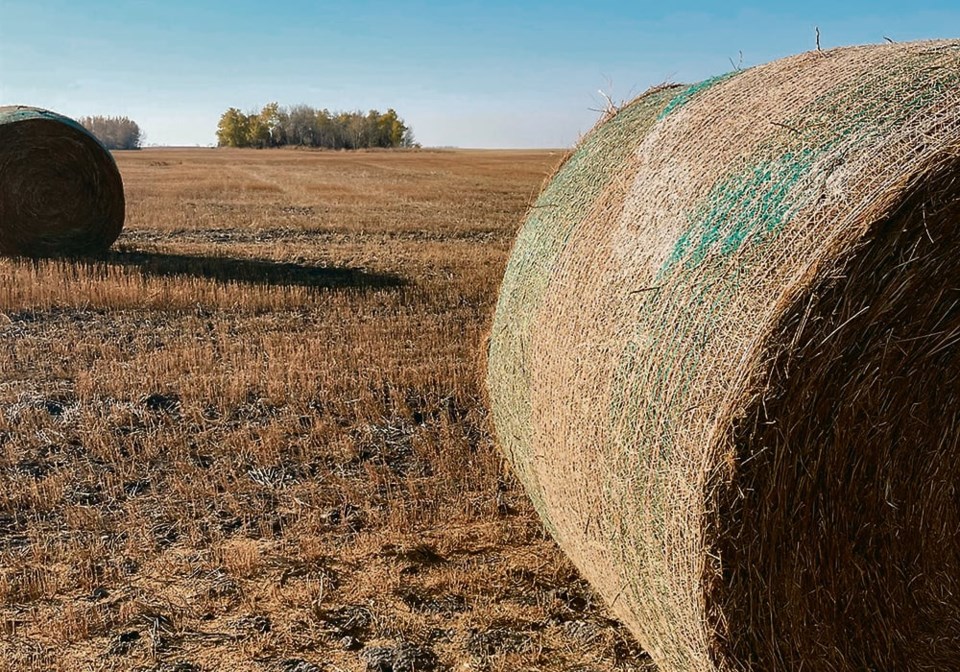WESTERN PRODUCER — The once-common practice of burning unwanted flax straw is happening less frequently in farm fields across Western Canada, according to sources in the industry.
Prairie flax producers still don’t have reliable access to “one or two major buyers of flax straw,” said Wayne Thompson, executive director at SaskFlax.
But local demand for flax straw is growing, particularly among dairy operators and livestock producers, who consider it an inexpensive alternative to cereal straw.
“Burning is not as common of a practice (as it used to be) for managing flax straw,” Thompson said in an email.
“Flax growers are working to sell their flax locally for livestock bedding or other uses. And as combines increase in horsepower and the choppers are better, flax growers are finding the flax straw can be chopped and spread on the field.”
Ruben Dyck, a dairy operator from Hague, Sask., said he has been using flax straw as bedding for nearly a decade.
“The first year I started dairy farming, about eight or nine years ago, I could not find any wheat straw,” Dyck said.
“The only thing I could find was flax straw, and I kind of came to like it.”
Dyck appreciates flax straw for its affordability, its availability and its functionality.
He now uses about 700 flax bales per year, spreading it in outdoor shelter areas and corrals.
“First of all, the cows will eat a fair bit of it if it’s at least a year old, so I think it cuts down on feed costs …,” Dyck said.
“I also like it in the corrals.”
Compared to cereal straw, flax stands up well to moisture and firms up mucky spots in corrals, making for cleaner and healthier animals.
“They (the corrals) are not as muddy,” Dyck said.
“There are other farmers that have told me that too. They like to put it in the really wet spots and it helps to firm up the corrals.”
Care should be taken when spreading used flax bedding with manure spreaders, Dyck added.
After corrals are cleaned, the straw should be piled and left to decompose for a least a couple of months. Moving the pile or turning it once or twice will speed the decomposition process.
“One dairy farmer told me he tried (spreading flax straw) one year and he’d never do it again because it wrecked all of his manure spreaders,” Dyck said.
“You have to be a bit careful. You can’t just put it straight into the manure spreader. You have to put it on a pile. Maybe move the pile again and let it decompose because if you don’t let it decompose, you will wreck your manure spreaders.”
Ron Thorhaug, a farmer from Willow Bunch, Sask., said his first attempt at selling flax straw was positive.
Within 24 hours of listing his flax straw bales for sale on a popular online marketing site, he sold all of them to two separate buyers.
“(We) listed it one night and the next morning by nine o’clock I had it all sold,” said Thorhaug.
“Eighty bales went to one guy and the balance went to another guy from Ponteix,” he said.
Thorhaug said flax bales make an affordable source of bedding. Palatability also increases if the bales are aged for a year or two, he added.
“One buyer was using it for windbreaks,” he said.
“If you leave flax straw to break down for a couple of years, like in a windbreak, after two or three years, the cattle will start to enjoy it.”
Thorhaug said he’s even heard of some cattle producers adding a liquid-based molasses supplement to flax bales to increase palatability.
Regardless of how it’s used, Thorhaug said selling excess straw is preferable to burning.
His first experience selling the straw will probably change his approach to flax straw management.
“I’ll do it again,” he said.
A few years ago, a start-up company called Prairie Clean Energy (PCE) announced plans to set up a large-scale flax straw processing plant in Saskatchewan.
PCE said it would buy flax straw from prairie flax producers and use it to produce high-density biofuel pellets for use in domestic and foreign energy markets.
In a recent interview, PCE founder Trevor Thomas said his company is still moving ahead with plans to turn flax straw into a valuable alternative fuel source.
“I believe it’s a valuable commodity,” he said.
The COVID-19 pandemic and subsequent supply chain disruptions have thrown PCE’s start-up plans behind schedule.
“Really what slowed us down was supply chain issues and getting the right production equipment that we need,” Thomas said.
“We already have a building in place in Regina for our first facility and we plan on being in operation here next (year).”
Thomas said PCE is continuing to work with Saskatchewan flax farmers to discuss contracting opportunities and delivery timelines.
Eventually, PCE intends to expand aggressively and build additional processing plants at locations throughout the Prairies.
According to Thomas, about 120,000 tonnes of flax straw will be processed annually at each PCE processing plant.
“We might not be buying (straw) yet but we are doing the work behind the scenes,” he said.

